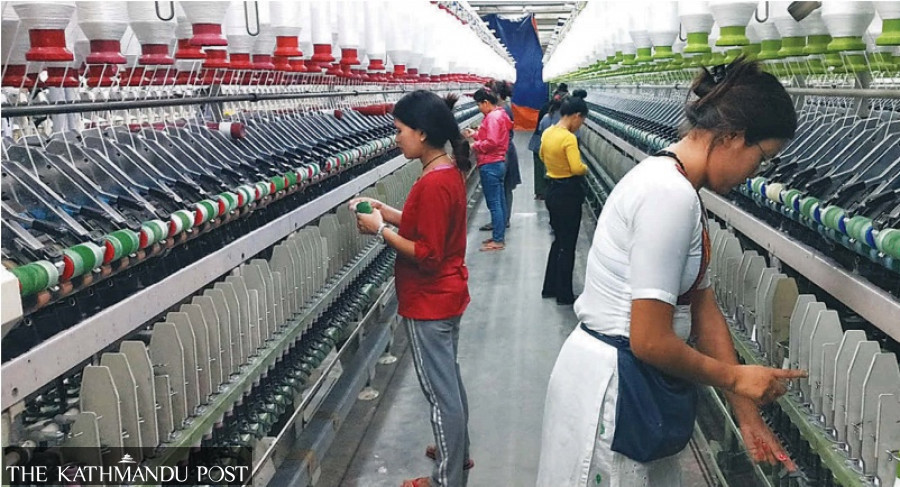Money
Nepal's manufacturing sector rebounds to near pre-pandemic levels
Tourism and transportation have not been able to regain their footing due to unclear policy, insiders say.
Krishana Prasain
The manufacturing sector has bounced back from the coronavirus disaster to near pre-pandemic levels with the lockdown lifted, the vaccination drive picking up and the festival season in full swing.
Dinesh Shrestha, vice-president of the Federation of Nepalese Chambers of Commerce and Industry, said all sectors except tourism and transportation had returned to their old selves due to robust market demand.
“Figures related to industrial production have not come in yet, but almost all factories are operating at full capacity,” he said.
"There is no clarity in the monetary policy regarding the tourism and transportation sectors; and as a result, there seems to be confusion about going into full operation. Entrepreneurs are seeking a time extension for interest payments on old loans. The transportation sector too is slowed down as there is little movement of people."
Shrestha said cottage and small scale industries had resumed operation and were waiting for the monetary policy to be implemented. “We are receiving complaints from cottage and small scale entrepreneurs that they are not able to get the promised interest subsidy easily.”
In the last fiscal year, Nepal witnessed a negative economic growth of 2.1 percent. It was the first time in nearly four decades that the country’s growth had gone into negative territory.
"People have started getting vaccinated, and the drive needs to be expanded rapidly so that there will be no need for lockdowns like in the past," Shrestha said.
Industrialists said that the lockdowns still in effect in some districts had not impacted production.
Manufacturers of construction materials said that due to a decline in demand for their products, factories had not come into full operation. The rainy season is the off-season for the building industry, and demand for construction materials plunges during this time.
"This year the rains were heavier and work was hit more than last year; consequently, the drop in demand is steeper this year," industry insiders said.
According to a follow-up survey report on the impact of Covid-19 on the economy published by Nepal Rastra Bank, industry and business were doing better in mid-April this year compared to the same time last year. Improvements were observed in production, transaction and employment.
The participants in the survey said that turnover had shrunk due to a decrease in market demand. Industrialists said that they were having a hard time getting refinance and subsidised loans. They faced problems obtaining additional credit, paying their back instalments and getting bank support, they said.
The manufacturing industry was operating at 80 percent of capacity as of mid-April this year while it was operating at 34.2 percent of capacity in mid-July,
Another lockdown lasting nearly two months was enforced from April 29 in response to the second wave of the coronavirus, which again impacted different sectors of the economy.
Dhruba Raj Thapa, president of the Cement Manufacturers Association of Nepal, said that cement factories were not able to operate at even 30 percent of capacity due to a sharp fall in demand despite the end of the lockdown.
"The pandemic resulted in a drop in demand for cement in the market as economic activities slowed down," he said.
“Cement factories are struggling to survive as demand is down. There are 64 cement plants in the country, and three to four of them have closed down. Those that are running are operating at minimum capacity,” he said.
“There is a huge gap in output and demand in the market currently. Nepal's cement industry has a production capacity of 22 million tonnes annually, and this will rise to 25 million tonnes in the current fiscal year. Demand reached around 9 million tonnes in the last fiscal year," he said.
“We are hopeful that there will be an improvement in demand after Dashain and Tihar,” he said. "Internal consumption needs to be increased by constructing concrete roads, and ways to export the product should be explored."
Krishna Kumar Phuyal, president of the Footwear Manufacturers Association of Nepal, said that Nepal's footwear industry was operating at 25 percent of capacity. "The festival season is on and the sector is expecting an increase in demand," he said.
There are 1,501 small, medium and large footwear factories in the country, and all of them are running.
Demand has been improving with the lifting of the lockdown, and the number of Covid-19 cases is also declining gradually. But the market is not as it was before the pandemic, analysts said.




 18.12°C Kathmandu
18.12°C Kathmandu















